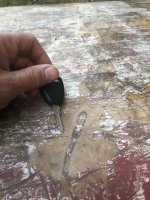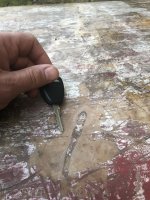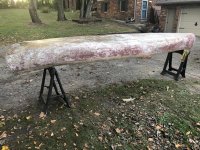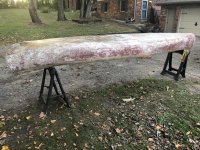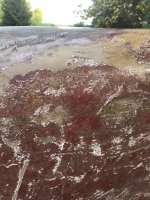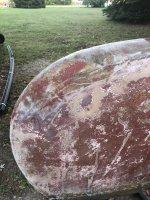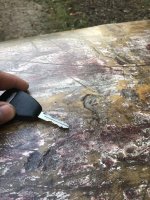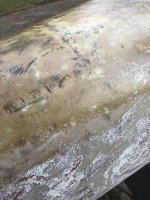I have finally gotten all the pieces and have been sanding for a couple days. This is an older canoe of unknown make. It is incredibly light and I have a feeling may be kevlar. How do I tell?
I know it has a layer of fiberglass sheet all along the bottom (kind of like a skid plate) and it appears to have 2 layers of fiberglass on the bow and stern (like skid plates but all the way up to the tip). This almost looks like it was done during original construction. The bow and stern are incredibly smooth (not like raised skid plates). However, the glass sheet across the bottom of the hull does have some bumps and bubbles; though blends incredibly smoothly into the sides.
There isn't any gelcoat that I can tell; though there are 3 distinct "colors" that I can make out on the outside. There is a red spray paint layer, a white translucent coating on the bottom, and a greenish translucent color on the upper. By translucent, you can make out the weave of the fabric through it. Almost like the resin was tinted.
I am having a couple issues. With no real gelcoat, as I am sanding away the gouges and bumps and bubbles on the bottom of the hull, I am exposing the fiberglass mat. I assume I need to re-cover this with resin before I paint the canoe?
I know I won't ever get this thing incredibly smooth; but, I do want to get it as good as I can. I can keep sanding the high spots on the bottom of the hull;but, I am just going to be grinding into this fiberglass sheet. Should I, instead, build up the low spots and then sand down? And, if so, how? I would say a good 1/3 of the bottom has dips, gouges, bubbles that have been sanded away, etc. I will be filling a LOT of area...and I don't want to add more weight than I have to.
Thoughts???
I know it has a layer of fiberglass sheet all along the bottom (kind of like a skid plate) and it appears to have 2 layers of fiberglass on the bow and stern (like skid plates but all the way up to the tip). This almost looks like it was done during original construction. The bow and stern are incredibly smooth (not like raised skid plates). However, the glass sheet across the bottom of the hull does have some bumps and bubbles; though blends incredibly smoothly into the sides.
There isn't any gelcoat that I can tell; though there are 3 distinct "colors" that I can make out on the outside. There is a red spray paint layer, a white translucent coating on the bottom, and a greenish translucent color on the upper. By translucent, you can make out the weave of the fabric through it. Almost like the resin was tinted.
I am having a couple issues. With no real gelcoat, as I am sanding away the gouges and bumps and bubbles on the bottom of the hull, I am exposing the fiberglass mat. I assume I need to re-cover this with resin before I paint the canoe?
I know I won't ever get this thing incredibly smooth; but, I do want to get it as good as I can. I can keep sanding the high spots on the bottom of the hull;but, I am just going to be grinding into this fiberglass sheet. Should I, instead, build up the low spots and then sand down? And, if so, how? I would say a good 1/3 of the bottom has dips, gouges, bubbles that have been sanded away, etc. I will be filling a LOT of area...and I don't want to add more weight than I have to.
Thoughts???

